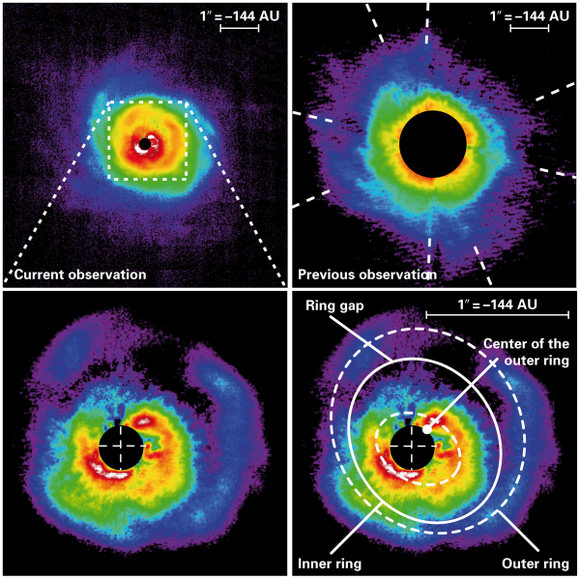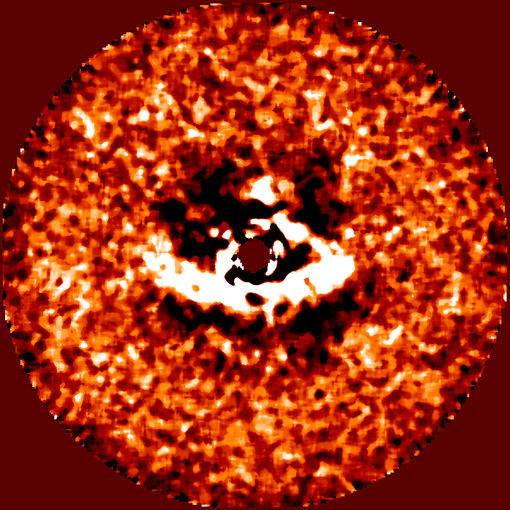[/caption]
Chalk up a sizzling success for the HiCIAO planet-hunter camera on the Subaru Telescope in Hawaii: it’s captured this unprecedented image of a stellar disk similar in size to our own solar system, featuring rings and gaps that are associated with the formation of giant planets.
The lead image shows a bright arc of scattered light, in white, from the protoplanetary disk around the young star LkCa 15. LkCa 15 is in the center of the image, blacked out. The arc’s sharp inner edge traces the outline of a wide gap in the disk. The gap is decidedly lopsided – it is markedly wider on the left side – and has most likely been carved out of the disk by one or more newborn planets that orbit the star.
The disk gap is large enough to house the orbits of all the planets in our own Solar System. “We haven’t detected the planets themselves yet,” said Christian Thalmann, who led the LkCa 15 study while on staff at the Max Planck Institute for Astronomy.”But that may change soon.”
LkCa 15, aged a few million years, is in the Taurus constellation about 450 light years away.
The observations are part of a systematic survey called SEEDS, or the Strategic Explorations of Exoplanets and Disks with Subaru Project, with a goal to search for planets and disks around young stars using HiCIAO, a state-of-the-art high-contrast camera designed specifically for this purpose. The lead investigator on the project is Motohide Tamura at the National Astronomical Observatory of Japan, but it’s a collaborative effort with international participation. Their first significant discovery — an exoplanet candidate around a sun-like star — was announced in December.
Besides LkCa 15, the researchers have also captured a sharp images of the protoplanetary disk around the very young star AB Aur in the constellation Auriga, “the Charioteer.” Lead researcher Jun Hashimoto, of the National Observatory of Japan, and his team report nested rings of material that are tilted with respect to the disk’s equatorial plane, and whose material, intriguingly, is not distributed symmetrically around the star – irregular features that indicate the presence of at least one very massive planet.

The researchers point out that no other telescopes, whether ground-based or in space, have ever penetrated so close to a central star, showing the details of its disk.
Planetary systems like our own share a humble origin as mere by-products of star formation. A newborn star’s gravity gathers leftover gas and dust in a dense, flattened disk of matter orbiting the star. Clumps in the disk sweep up more and more material, until their own gravity becomes sufficiently strong to compress them into the dense bodies we know as planets.
Sources: Max Planck Institute For Astronomy, National Observatory of Japan.
Links to the published results:
Thalmann, C. et al., Imaging of a Transitional Disk Gap in Reflected Light: Indications of Planet Formation Around the Young Solar Analog LkCa 15 in Astrophysical Journal Letters 718, p. L87-L91
Hashimoto, J. et al., accepted for publication in Astrophysical Journal Letters in January 2011.


“- Fascinating.” [/lopsided eye brow lift]
I see the disk, I’m willing to see the gap, but honestly any structure in that looks to be the scale of image artifacts.
Similarly for AB Auriga, there is visible structure but I would describe it as ‘irregular clumps’ more than rings.
Question: is there some more solid evidence supporting these claims? Image analysis or something?
04h 39′ 17.78″ +22Deg 21′ 3.5″
Thanks for coords!
Hi Manu,
I forwarded your question to Christian Thalmann, lead author of the LkCa 15 study, and here is what he said:
… Your article suggests that “rings and gaps” are
seen in the LkCa 15 image. I would apply that term only to the varied
structures seen in the AB Aur image. As the commenter notes, not much
can be seen of the fine structure of the LkCa 15 apart from its
lopsided gap. That one is rather solid though, as it is supported by
several resolution elements on either side. These are also the
strongest gradients in the image and thus unlikely to be artificially
produced during the angular differential imaging process. There is a
more detailed discussion in the paper itself, which is freely
available here:
http://arxiv.org/abs/1005.5162
The substructure in the AB Aur image is definitely significantly above
the noise level, as demonstrated in the paper, which will be on the
same pre-print server very soon.
Thanks! =)
Good catch! [/eye brows]